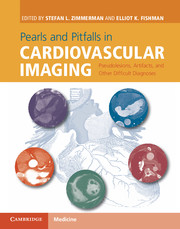 Pearls and Pitfalls in Cardiovascular Imaging
Pearls and Pitfalls in Cardiovascular Imaging from Section 11 - Veins
Published online by Cambridge University Press: 05 June 2015
Imaging description
Filling defects within the inferior vena cava at CT or MRI may be a result of flow artifacts (Figures 93.1 and 93.4), bland thrombus (Figure 93.2) or tumor thrombus (Figure 93.3). Within the inferior vena cava, the most common filling defect seen on CT is pseudothrombosis caused by laminar flow of enhanced blood from the renal veins streaming parallel to the column of unopacified blood returning from the lower body. Its appearance is usually characteristic. Coronal image may be helpful to show the characteristic pattern of a filling defect in relation to the renal veins (Figure 93.1). Artifactual filling defects may also result from poorly enhanced blood flowing into an opacified inferior vena cava, such as inflow from hepatic veins (Figure 93.4).
Artifactual filling defects can also be seen in other venous systems such as the internal jugular vein, portal vein, superior mesenteric vein (Figure 93.5), gonadal vein, and iliofemoral vein.
Importance
Artifactual filling defects seen in the venous system on CT and MRI can mimic true thrombus. Delayed imaging after administration of intravenous contrast material may be helpful for further characterization (Figure 93.5), and familiarity with anatomy and flow effects is important to distinguish between pseudo filling defects and true thrombus.
Typical clinical scenario
Typically, pseudothrombosis is seen when enhanced and unenhanced blood flow is mixed related to normal anatomy (such as enhanced blood returning from renal veins mixed with unenhanced blood in the inferior vena cava from the lower body). Reflux of opacified blood mixed with unopacified blood may also cause pseudothrombosis; for example, retrograde contrast enhancement of the inferior vena cava in patients with right-sided heart disease (such as tricuspid regurgitation, pulmonary hypertension, and right ventricular systolic dysfunction), or related to a higher injection rate (>3ml/s) of contrast material.
Asymmetric opacification of the venous system such as the gonadal veins and iliofemoral veins can also be a cause for pseudothrombosis. Asymmetric reflux of opacified blood into the left gonadal vein, early venous return to the unilateral iliofemoral vein due to a portosystemic shunt, abdominal wall collateral veins, and renal transplant with renal vein and iliac vein anastomosis have been described as causes for pseudothrombosis.
To save this book to your Kindle, first ensure [email protected] is added to your Approved Personal Document E-mail List under your Personal Document Settings on the Manage Your Content and Devices page of your Amazon account. Then enter the ‘name’ part of your Kindle email address below. Find out more about saving to your Kindle.
Note you can select to save to either the @free.kindle.com or @kindle.com variations. ‘@free.kindle.com’ emails are free but can only be saved to your device when it is connected to wi-fi. ‘@kindle.com’ emails can be delivered even when you are not connected to wi-fi, but note that service fees apply.
Find out more about the Kindle Personal Document Service.
To save content items to your account, please confirm that you agree to abide by our usage policies. If this is the first time you use this feature, you will be asked to authorise Cambridge Core to connect with your account. Find out more about saving content to Dropbox.
To save content items to your account, please confirm that you agree to abide by our usage policies. If this is the first time you use this feature, you will be asked to authorise Cambridge Core to connect with your account. Find out more about saving content to Google Drive.